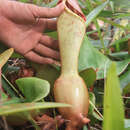Biology
provided by Arkive
Pitcher plants are dioecious meaning that male and female flowers grow on separate plants (4), and only begin to flower once the upper pitchers are produced (2). During the early evening and night, the flowers produce large amounts of nectar which evaporates by the morning. This nectar attracts flies during the early evening and moths at night to aid pollination. Once fertilised a fruit usually takes about three months to develop and ripen. The fruits each contain between 100 and 500 very light, winged, seeds, measuring up to 30 millimetres long which are thought to be dispersed by the wind (2) (4). Despite enormous numbers of seeds being produced, only a few manage to germinate and only a fraction of those survive to maturity (2).
Carnivorous pitcher plants are adapted to grow in soils low in nutrients. Although the plants do gain some nutrition through the soil, and energy through photosynthesis, they supplement this with a diet of invertebrates, usually consisting of ants, cockroaches, centipedes, flies and beetles. Insects are attracted to the pitchers by their bright colours and nectar, which is secreted by glands situated on the lid and the peristome of the pitcher. The insects fall into the acidic fluid at the base of the pitcher and, unable to escape, they drown. Digestive enzymes are then released to break down the captured prey (4).
Despite the hostile environment of the pitchers, they can be home to number of animals, such as the red crab spider (Misumenops nepenthicola). The red crab spider ambushes insects that crawl into the pitcher and preys upon other insects, such as mosquitoes, as they emerge from larvae that live in the pitcher fluid (2).
Conservation
provided by Arkive
Nepenthes clipeata does not grow in any protected area or national park. There is also no local awareness of its threatened status (2). Although listed under Appendix II on the Convention on International Trade in Endangered Species (CITES), which limits the international export of this species (3), trade is very difficult to regulate. There is no requirement for internationally traded Nepenthes to be identified down to species level and plants simply labelled as Nepenthes accounted for 94 percent of all exported Nepenthes plants between 1988 and 1993. This needs to be remedied and urgent attention is required to close other loopholes (2). Nepenthes clipeata is now being cloned from tissue culture helping to reduce the impact of private collections on the wild population (7). Detailed field surveys are required to fully assess the exact status of this species, before it disappears completely from the face of Mount Kelam (2).
Description
provided by Arkive
The tropical pitcher plants of Asia (Nepenthes) are amongst the largest and most spectacular of all carnivorous plants. Nepenthes clipeata is a red-stemmed vine that crawls along the ground (2), with fine roots that are attached to a creeping rhizome (4). From coiled tendrils hang modified pitcher-shaped leaves, into which insects and other invertebrates fall. Nepenthes species usually have two or three different types of pitcher, generally known as upper and lower pitchers (4). The cone-shaped pitchers of Nepenthes clipeata are white with red blotches (2), and contain an acidic fluid, secreted by the many glands, which cover the inside surface of the lower half of the pitcher (4). The smooth and waxy upper inner surface of the pitcher makes it impossible for captive insects to gain a foothold (4), and a ridge of hardened tissue lining the mouth of the pitcher, the peristome, bears downward pointing teeth, also preventing insects from escaping (2). A lid overhangs the mouth of the pitcher preventing rain water from diluting the pitcher fluid (2).
Habitat
provided by Arkive
Nepenthes clipeata grows in crevices along with grasses and Sphagnum moss species on the sheer granite cliffs of Mount Kelam, at altitudes between 600 and 800 metres (2).
Range
provided by Arkive
Found in the Kalimantan region of Eastern Borneo, where it is restricted to the slopes of Mount Kelam (6).
Status
provided by Arkive
Classified as Critically Endangered (CR) on the IUCN Red List 2007 (1) and listed on Appendix II of CITES (3).
Threats
provided by Arkive
Nepenthes clipeata is in serious danger of becoming extinct in the wild. This species is prized by collectors and virtually all accessible plants have been removed. In 1995, only 15 known plants remained. It has an extremely restricted distribution making it vulnerable to habitat loss and degradation, and catastrophic events such as drought and fire. Recently, much of the vegetation on Mount Kelam was burned, damaging the habitat and further reducingthe ability of Nepenthes clipeata to recover from over collection (2).

